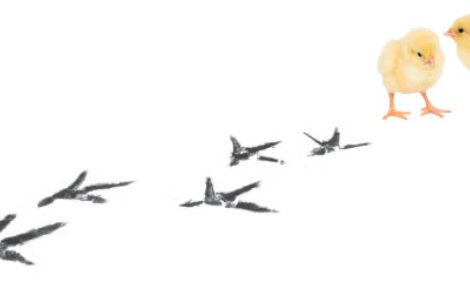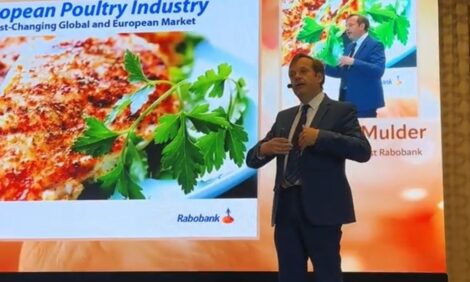



India's Poultry Sector: Development and Prospects
By Maurice Landes, Suresh Persaud, and John Dyck, U.S.D.A., Economic Research Service - Poultry meat is the fastest growing component of global meat demand. India, the world’s second largest developing country, is contributing to the expansion through the rapid growth of its poultry sector.
Abstract
In India, poultry sector growth is being driven by rising incomes, together with the emergence of vertically integrated poultry producers that have reduced consumer prices by lowering production and marketing costs. Integrated production, a market transition from live birds to chilled and frozen products, and policies that help ensure supplies of competitively priced domestic or imported corn and soybeans are keys to future poultry industry growth in India and in other developing countries.
Executive Summary
Poultry meat is the fastest growing component of global meat production,
consumption, and trade, with developing and transition economies playing a
leading role in the expansion. In addition to providing opportunities to increase
poultry exports, rising poultry production spurs growth in global import demand
for feeds and other inputs and in investment opportunities in these sectors. India,
the worlds second largest developing economy, now has a large and rapidly
expanding poultry sector.
Expansion in India is being driven by rising incomes and
a shift in industry structure toward integrated ownership and coordination of the
input, production, and marketing operations involved in poultry production
(vertical integration). These factors, in addition to government policies affecting
feed supply levels, will help shape future growth in the poultry industry in India,
as well as in emerging trade and investment opportunities.
Several key findings based on developments in Indiafs poultry market may provide
insights to prospects for poultry industry growth in other developing countries:
Poultry meat demand is highly price sensitive among low- and middle-income consumers. Policies that protect the domestic poultry market may also slow growth in consumption and production.
Factors that discourage transport and distribution of poultry within India, including limited demand for frozen products, a poor and high-cost transport infrastructure, and limited and unreliable cold chain, or frozen storage, facilities, are also strong impediments to poultry imports and may be as important as tariffs in constraining trade.
Vertical integration can promote industry growth by enhancing production and marketing efficiency and reducing consumer prices. In India, the gains in marketing efficiency appear more significant than in production efficiency.
Competitive feed prices are key to competitive poultry and egg production. Policies that protect local feed producers are also likely to slow growth in poultry and egg output, imposing significant losses on producers and consumers.
Implications for U.S. Agriculture
Prospects for Indian imports of poultry meat are limited. Competitive local production
costs, low demand for frozen meat, and poor cold chain facilities, as well as high
tariffs, are major constraints to trade. Growth in demand for corn and soybean meal,
however, will likely outstrip gains in local production, creating demand for corn
imports and reducing exports of soybean meal. Indiafs corn import policy, and the
pace of gains in corn and soybean productivity, will influence the amount of trade.
Foreign direct investment (FDI) has, so far, not been a major factor in the development
of India's poultry sector. But India's fast-growing, competitive, and potentially
large industry offers investment opportunities in input activities, such as
breeding, medicines, feed, and equipment, as well as vertical integration and
processing. While the country permits FDI in these activities, investments are
constrained by market and policy uncertainty, poor power and transport infrastructure,
and high taxes on processed food.
Incomes, Changing Market Structure, Drive Growth
Available data indicate that, since the early 1990s, poultry meat has been the
fastest growing sector of animal product production and consumption in India.
Factors driving the industry’s expansion include quickening growth in per capita
incomes, a young and increasingly urban population, and declining real poultry
prices. With recent studies suggesting that most Indians do not have strict vegetarian
dietary preferences, income and price are likely to continue to influence
rising demand.
The expanding role of poultry integrators, primarily in South and West India, has
contributed to declining poultry prices. Integration, typically encompassing enterprises
ranging from breeding, feed milling, and contract growing to wholesale and
retail marketing, appears to have increased production efficiency and significantly
reduced marketing margins and consumer prices. Future industry expansion may
depend on the pace at which integrated poultry operations spread in the West, East,
and, particularly, the affluent North.
Expansion of poultry sector integration, in turn, may depend on the pace of transition
in India’s poultry sector from a live-bird market to a chilled/frozen-product
market. Live-bird sales now dominate the market, preventing exploitation of
regional comparative advantages in production, or the use of storage, domestic
product movements, and international trade to stabilize supplies and prices. A shift
to mechanical, and more hygienic, processing that would be an integral part of a
transition to a chilled/frozen-product market may also have public health benefits,
although there is little evidence that current practices are creating health problems.
Competitive Production Costs
Data also suggest that India is an internationally competitive producer of poultry
meat. Producer prices of whole birds in India, while higher than in Brazil, compare
favorably with those in other Asian countries and the United States. Poultry
production in India benefits from improved management practices and the availability
of local supplies of corn and soybean meal at internationally competitive
prices. Competitive local prices, combined with high tariffs, poorly defined
phytosanitary requirements, and a limited market for frozen poultry, are constraints
to significant poultry meat imports in the near term.
If recent trends in poultry and egg production in India are sustained, growth in
demand for corn and soybean meal is likely to outpace gains in domestic production.
For corn, variable domestic production, expanding feed use, and tariff and
quota restrictions on corn imports could combine to constrain growth in both the
poultry and egg industries, raising production costs and consumer prices and
slowing consumption. For soybean meal, the Indian poultry and egg industries
benefit from local surpluses and ready availability, although rising internal demand
may erode exports.
Policies Affecting Market Integration and Feed Trade Key to Future Growth
With the expansion of India’s poultry industry, the country’s government must
address a number of new issues, including economic tradeoffs between poultry
producers, feed producers, and consumers, potential public health concerns
associated with traditional slaughter and marketing practices, and appropriate tariff
and nontariff policies for imports of poultry and industry inputs. Although government
policy has traditionally given priority to promoting self-reliance in agricultural
products, it is unclear how future policy will weigh the competing interests
of, among others, poultry and egg producers, consumers, and feed producers.
Poultry sector integration can yield substantial benefits for the sector and, particularly,
consumers of poultry meat. Feed shortages, however, can have significant
adverse effects on producers and consumers of poultry meat and, particularly, eggs.
Although Indian corn producers may gain from higher prices associated with
import restrictions, these gains must be weighed against losses to producers and
consumers of poultry meat and eggs, as well as to the potential international
competitiveness of Indian poultry production. Development and adoption of technology
that can improve the competitiveness of domestic feed production would
allow all producers and consumers to benefit from poultry sector expansion.
Data Limitations Constrain Policymakers
Analysis of developments in India’s poultry sector is made difficult by the lack of reliable and timely official data on such variables as production, consumption, feed use, and production and marketing costs. Information from industry sources suggests that production and consumption of poultry meat in India has grown by as much as 15 percent annually since the mid-1990s, far faster than indicated by official data. Based on these findings, poultry will likely grow in importance to the Indian diet and to farm income and create new pressures for appropriate policies in industries that supply inputs to poultry producers, as well as in poultry processing and marketing activities. Better data and information will be needed to support public and private sector decisionmaking.
Links
To view the full article, please click hereSource: U.S. Department of Agriculture, Economic Research Service - September 2004








